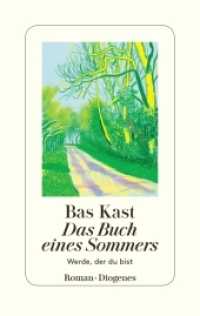- ホーム
- > 洋書
- > 英文書
- > Architecture
Full Description
The Routledge Handbook of Designing Public Spaces for Young People is a thorough and practical resource for all who wish to influence policy and design decisions in order to increase young people's access to and use of public spaces, as well as their role in design and decision-making processes.
The ability of youth to freely enjoy public spaces, and to develop a sense of belonging and attachment to these environments, is critical for their physical, social, cognitive, and emotional development. Young people represent a vital citizen group with legitimate rights to occupy and shape their public environments, yet they are often driven out of public places by adult users, restrictive bylaws, or hostile designs. It is also important that children and youth have the opportunity to genuinely participate in the planning of public spaces, and to have their needs considered in the design of the public realm.
This book provides both evidence and tools to help effectively advocate for more youth-inclusive public environments, as well as integrate youth directly into both research and design processes related to the public realm. It is essential reading for researchers, design and planning professionals, community leaders, and youth advocates.
Contents
SECTION 1 Introduction — WHY we need to include youth in the creation and use of outdoor public environments.
Chapter 1 A Fundamental Need: Linking youth development to the public realm
Chapter 2 Freedom to Flourish: Why independent mobility and access to the public realm is important for youth development
Chapter 3 Risky Play: Why children love it and need it
Chapter 4 Why Is It Important to Provide Child- and Youth- Friendly Streets?
Chapter 5 Experiential accessibly: A therapeutic approach to the design of the public realm
Chapter 6 Engaging Racially and Ethnically Marginalized Youth as Stakeholders of Outdoor Public Environments
Chapter 7 Youth-built Places: Engaging youth in the construction of public places
SECTION 2 Introduction — HOW can we create inclusive, youth-friendly outdoor public environments?
Chapter 8 Welcoming Young People in Urban Placemaking: Learning from challenges
Chapter 9 Turning Young People's Ideas into Action: Learning from long-term partnerships for child and youth participation
Chapter 10 The Power of Process: Shaping our public domains with young people
Chapter 11 'Green Direction': Illustrating a framework for integrating youth into the design and building of public spaces
Chapter 12 Philadelphia Youth Call for Equitable Development
Chapter 13 Through Engagement to Design: Working with children, young people and communities to improve green spaces in social housing areas
Chapter 14 Fluid Methodology: Investigating a re-imagination of youth friendly public places in the era of rapidly changing technology
Chapter 15 How to Use Big Data for Youth Inclusion: Lessons and insights from video-based social media research on adolescent free play in cities
Chapter 16 'Insideness' as the Lens for Understanding Pre-teens' Relationship with Place
Chapter 17 How to Integrate Photovoice and Multiple Participatory Methods: Lessons Learned from Collaborating with Tribal Youth in India to Explore their Surrounding Environment
Chapter 18 The Mission: Engaging Aboriginal Australian children in the redesign of community public spaces
Chapter 19 Behavior Mapping to Support the Development of Youth-Friendly Public Places
SECTION 3 Introduction — Youth Inclusion in Practice
Chapter 20 'Shaking the Movers': A rights-respecting youth participation model
Chapter 21 The Great Outdoors Colorado Inspire Initiative - Garfield County, CO
Chapter 22 Friendly for Play?: Engaging young people in examining their neighborhood play environments
Chapter 23 The Rocky Hill Trail: A path of transformation
Chapter 24 In from the Margins: Engaging Latinx youth in Chicago's Little Village
Chapter 25 From Noisy Coexistence to Inclusion-through-Resistance: (Re)placing youth at London's 'Southbank' skate spot
Chapter 26 Parisite, New Orleans: Some place to play
Chapter 27 Living with Nature, Sheffield, England
Chapter 28 Play Streets to Play Quarters
Chapter 29 Youth Planning + Designing for Play: 'The Hangout'
Chapter 30 The Manzanita Gathering Place: Engaging marginalized youth in creative place making
Chapter 31 Mindful Mapping: An integrated approach to helping youth navigate neighborhood change








